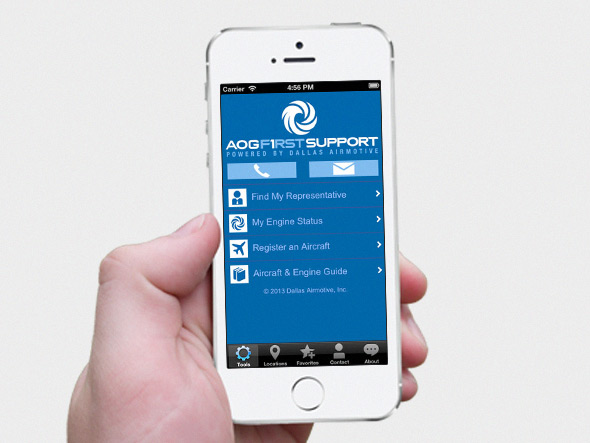How to Decide if You Need an Aviation App
06.25.14 · Greteman Group
First a couple of facts. The number of smartphones and tablets in use in the world is well over a billion. And there’s more than 1.5 million apps for those devices. So with all the hype about mobile you might be saying to yourself “I need an app developed for my company. Not want. NEED. I will literally DIE if I this does not happen… right now.” I completely understand the draw. Apps are shiny and magical. On my 32GB iPad, I have well over 300 apps. So I know a thing or two about app addiction. But before you run off and jump on the app bandwagon because all the other kids, I mean CEOs, have one, there’s something else to consider.
Remember your website? You know, that thing that you used to love and pay attention to before you were lured with the siren song of the app? It’s still there, and it’s still just as important. Over the past few years, there’s been tremendous growth in mobile website browsing. It won’t be long before more people are viewing websites on mobile devices than desktop computers. So in order to plan for that, you’ll need to make your website responsive. That’s a technique that allows your site to alter its design based on the size of the device viewing it in order to give viewers the best possible experience. It future-proofs your site because you’re not designing to specific screen sizes. If a new mobile device comes out with a difference size screen than other devices, the site automatically takes care of it.
Because it’s necessary to make sure your website looks great on mobile devices anyway, the question changes from “When the *&^% will my app be ready?” to “Do I really need an app, or can a mobile site handle the job?” The following considerations can help you make that determination.
Function
Whether or not you need an app starts with what you would want it to do. There are some things an app can do that isn’t practical or even possible with a mobile site. Complex animation and interactivity, like the kind you would see in a game like Angry Birds, would be difficult to replicate on a mobile site and still maintain its fluidness. Since video can be played locally from the app without having to download anything from the Internet, the experience can be faster and more enjoyable. Another consideration is that apps have access to certain phone features like the camera that, while possible with some mobile devices, isn’t as easy to implement. And while apps will often times require an Internet connection the same way a mobile site does, they can in some cases handle being offline better than a mobile site. One thing to note is that as technologies advance, the functional differences between apps and mobile sites are decreasing.

Cost
A mobile site will often cost less than an app. This is because mobile sites are built in standard web technologies that make development quick. There are several factors that play into this though. If the app is relatively simple, and the mobile site involves taking a large existing site and making it responsive, the app could very well be cheaper. The cost of a mobile site can be reduced by building one that is separate from the desktop version rather than a full-blown responsive site, as long as you realize that this is a stopgap measure, and that your ultimate goal should be to make your site responsive.
Development and Maintenance
Once you’ve adapted your website for mobile using responsive design, you’re done. It should work on any type of device. An app however, needs different versions based on what platform it’s being viewed on. So if you’re needing to have your app available to all mobile users, you’ll need to at least maintain versions for iOS, Android and Windows-based devices. You’ll also need to take into consideration that these platforms have both smaller screen devices like the iPhone, and tablet devices like the iPad. You can either develop separate apps for each type of device, or create universal apps that work on both smartphones and tablets. In either case, it is additional work.
Once your app is developed for all the necessary platforms, you need to get it out to the world. For iPhone and iPad apps, this means submitting the app to Apple’s App Store. You’ll need to be a certified Apple developer to do so – they don’t let just anyone join the party. Once submitted, it can take days or weeks for Apple to review it before it’s allowed into the App Store. Or not, as Apple will often times kick an app back to the developer for changes before it’s accepted. And every time you makes changes to the app – which tends to happen frequently for the apps I use – you’ll need to resubmit to Apple to review again. With a mobile website, there’s no submission or review process at all. Once you’re done, the site is accessible immediately. And any changes you make to the site later on are likewise instantaneous.
User Experience
An advantage that apps have over mobile sites is in the ease of access. It’s easier to touch an icon on your home screen than open up your mobile device’s web browser and find the site you’re looking for. Although it is possible to save a mobile site as a shortcut on your home screen that functions in the same way as an app’s icon, it takes an extra step that fewer people know how to do.
On the other hand, if you’ve found a great mobile site you want to share, it’s much easier to share a direct link to that site through Facebook or Twitter than to point people to an app that they’ll have to find and download. Not to mention the fact that mobile sites can be found by Google or any other search engine, while it can be more difficult to find an app you’re looking for.
The Final Decision
The similarities and differences between mobile sites and apps can make it difficult to know which to choose. While you’re making a decision, here’s a quick recommendation:
If you don’t have a compelling reason to choose an app over a mobile site, don’t.
This might not be what you want to hear, I realize. You might want me to say “One app? Screw that, make three or four apps!” and then sing love songs about your iPhone. But the truth is, it’s quite possible that a responsive site is all you need.
And don’t forget that there is a third option. It’s not unreasonable to have both a responsively designed site and an app, as long as there’s some distinction between what their purposes are. For example, Dallas Airmotive has a responsive site that is both functional and informational, as well as an app that has exclusive features for its customers. So you can have your cake and eat it too. And then play the My Cake Shop app on your iPad. Yes, that’s a real thing.

This column ran in the June 26 issue of BlueSky Business Aviation News.
